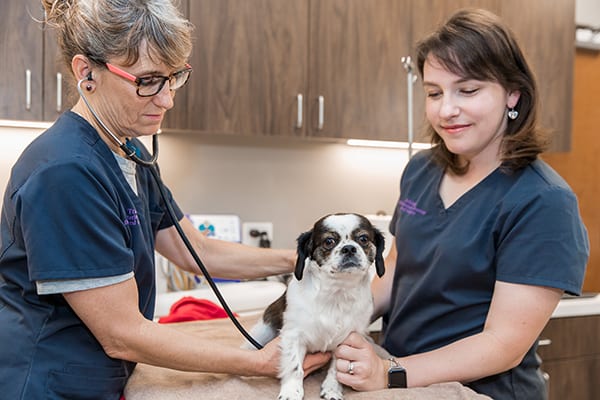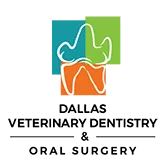Helpful Links & FAQ
We have gathered a variety of educational resources together to give our clients additional valuable information about pet dentistry. Dental care is extremely important for our four-legged family members but is often the easiest to overlook. For advice, standard veterinary dentistry terms, home care instructions and more, please browse the links and FAQ below. Don't see an answer to your question? Give us a call at (817) 431-8451.

Helpful Links
FAQ
- We perform a general exam before anesthesia (depending on patient cooperation), which includes evaluating the bite, doing preoperative blood testing to check organ function, and identifying any signs of gum infection, abnormal wear patterns on the teeth, and oral tumors.
- The patient’s vital signs are obtained and recorded and an intravenous catheter is placed prior to introducing general anesthesia
- The doctor carefully examine each tooth, the tongue, gums, tonsils, and lymph nodes while the patient is under anesthesia
- The teeth are cleaned above and below the gum line
- The teeth are polished
- The tissues are irrigated (removing plaque and tartar debris from the mouth with a stream of water)
- A thorough post-dental cleaning examination and digital X-rays are obtained for each patient
- Findings are documented during dental charting to record observations, abnormalities, and types of treatment used
- Therapy is provided as needed
- One of the doctors meets with the client at discharge showing them photos and X-rays of before and after the procedure/treatment
- A doctor or veterinary dental technician provides home care instructions
- Periodic follow-up appointments to check in on your pet’s health and see how well you are managing their dental care at home
Consultations are $154.
Once patients are admitted for treatment, the minimum charge is approximately $1,085. This includes a comprehensive oral exam and evaluation under general anesthesia where the doctor carefully examine each tooth, the tongue, gums, tonsils, and lymph nodes. Also included are full mouth dental radiographs, intravenous (IV) fluids, general anesthesia and patient monitoring, patient recovery/nursing care, and complimentary dental home care items (Hill’s Science Diet TD Chunks, Virbac C.E.T. Enzymatic Toothpaste and Chlorhexidine Oral Rinse).
All patients that receive treatment can also receive oral consultation examinations every 12 months for life, at no additional cost.
Once your pet has been fully evaluated under general anesthesia, one of our dental specialists will call to discuss their findings and treatment recommendations. At that time your treatment estimate may be updated if needed. Additional treatment, blood work (if not completed prior), and medications are provided at additional costs.
Daily plaque removal is essential to your pet’s oral hygiene. Without daily teeth brushing, plaque, which supports bacteria accumulation, will begin to build up under and along their gum line. In time, calculus begins to form, causing further irritation. This enables the infection to progress and damage the supporting tissues around your pet’s teeth. Along with causing teeth to become loose, subgingival (below the gum line) infection may also spread to the heart, liver, and kidneys if bacteria finds its way into the bloodstream.
Use a soft-bristle or finger toothbrush that is gentle on your pet’s gums. Second, purchase pet-friendly toothpaste from your veterinarian. Toothpaste for humans can be harmful to pets, so avoid using it. Apply a small amount of the toothpaste to the brush and in gentle, circular motions, brush the outside of your pet’s upper cheek teeth. Focus on where the tooth meets the gum line.
This depends on how quickly and to what extent plaque and tartar build up on your pet’s teeth. Try to check your pet’s teeth on a monthly basis. Look for yellow or brownish discoloration where their tooth disappears into their gums. Be sure to pay special attention to the canines and cheek teeth, where most plaque and tartar accumulation occurs. If you notice accumulation, then your pet is due for a professional cleaning. The tartar on your pet’s teeth contains bacteria that cause irritation to the gums (gingivitis). If this gingivitis is left untreated, it will eventually turn into periodontitis, which can do irreversible damage.
Furthermore, the intervals between your pet’s professional cleanings will depend on how frequently you brush your pet’s teeth at home. Ideally, you should brush their teeth 1-2 times a day. If you are unable to brush your pet’s teeth, they might need 2-3 professional cleanings per year.
Dental disease takes place below the gum line. Removing calculus from the visible crown does not treat the dental disease occurring below the gum line. Additionally, using anything to scrape your pet's teeth can scratch the enamel, creating a rough surface that encourages more plaque and tartar formation.
To properly and safely clean your pet’s teeth and eradicate disease below the gum line, we will need to place them under anesthesia. Anesthesia is also necessary for a complete oral exam and dental X-rays. The 3 main functions of anesthesia include:
- Immobilization so we can clean below the gum line without causing stress to your pet, which could result in damage to their gums or other oral tissues
- Pain control
- The ability to place a tube into the windpipe to prevent bacteria and debris from entering the respiratory system
Overall, anesthesia makes professional dental cleanings safe and more comfortable for your pet.
Our specialists make every effort to make sure that anesthesia is safely administered. We use the safest anesthetic agents. Additionally, all dogs and cats undergo preoperative testing to ensure that they are candidates for anesthesia. During anesthesia, all pets are carefully monitored with state-of-the-art equipment such as EKG (heart rhythm), pulse oximeter (oxygen content of the blood), capnograph (measuring carbon dioxide exhaled), Doppler, and oscillometer blood pressure monitors.
Hard food is the best option for removing plaque from the teeth. There are also diets made specifically for keeping dogs’ and cats’ teeth clean. It’s important to provide this diet together with daily brushing for the best results. Food will not prevent plaque buildup on its own.
If your pet chews on anything that is harder than their teeth, this could result in tooth fractures. Be wary of cow and horse hooves, animal bones, hard nylon bones, and antlers. Avoid tug-of-war games with your cat or young dog (this can shift the positions of growing teeth). The impact of a hard plastic frisbee on your dog’s teeth can also cause inflammation of the pulp tissue (pulpitis).
Many cats can develop painful lesions along the gum line that grow into the teeth. These lesions are known as feline odontoclastic resorptive lesions (FORLs). This condition does not have a known cause, and the best treatment is the extraction of the affected tooth. To check for resorptive lesions, take a cotton-tipped applicator and gently press it to your cat’s gum line. If a painful lesion is present, your cat will chatter its jaw. Seek treatment right away.
Bad breath is the most obvious sign and is caused by infection. If you notice that your pet has less-than-pleasant breath, let us know so we can examine your pet’s mouth and recommend a treatment plan.
If we see that periodontal disease is present or notice that your pet has a fractured tooth, we will need to perform an oral exam while they are under anesthesia. We use a periodontal probe to assess bone loss around each tooth, much like your dental hygienist would. Then we take radiographs to see if the teeth can be saved or if there are some that need to be extracted.
The sooner you start your pet’s dental care routine, the healthier they will be. Once your pet’s puppy or kitten teeth emerge, you should start brushing. While puppy and kitten teeth are eventually replaced by adult teeth, brushing when they’re young helps them get used to the procedure.
Periodontal disease occurs when tooth support structures are affected by infection. If periodontal disease is in its early stages, cleaning above and below the gum line and removing calculus from the surfaces of the teeth will restore your pet’s periodontal health. However, if periodontal disease has reached a more advanced stage, periodontal surgery or extractions will need to be performed. We can also use antibiotics in conjunction with other treatments, but these are not substitutes for daily at-home care and professional cleanings.
Small dog breeds such as Terriers, Shih Tzus, King Charles Cavaliers, Chihuahuas, Pomeranians, Schnauzers, and Maltese, as well as any of the brachycephalic (smoosh-faced) breeds, are more prone to periodontal disease than larger breeds. This is because their teeth are positioned more closely together, and these small dogs tend to live longer.
There are two options if your cat or dog breaks a tooth: root canal therapy to salvage the tooth, or extraction. Leaving a tooth with an exposed nerve is very painful and can leave the tooth vulnerable to infection. It simply is not humane to leave a broken tooth untreated. If you notice that your pet has a broken tooth, seek treatment for them immediately.



